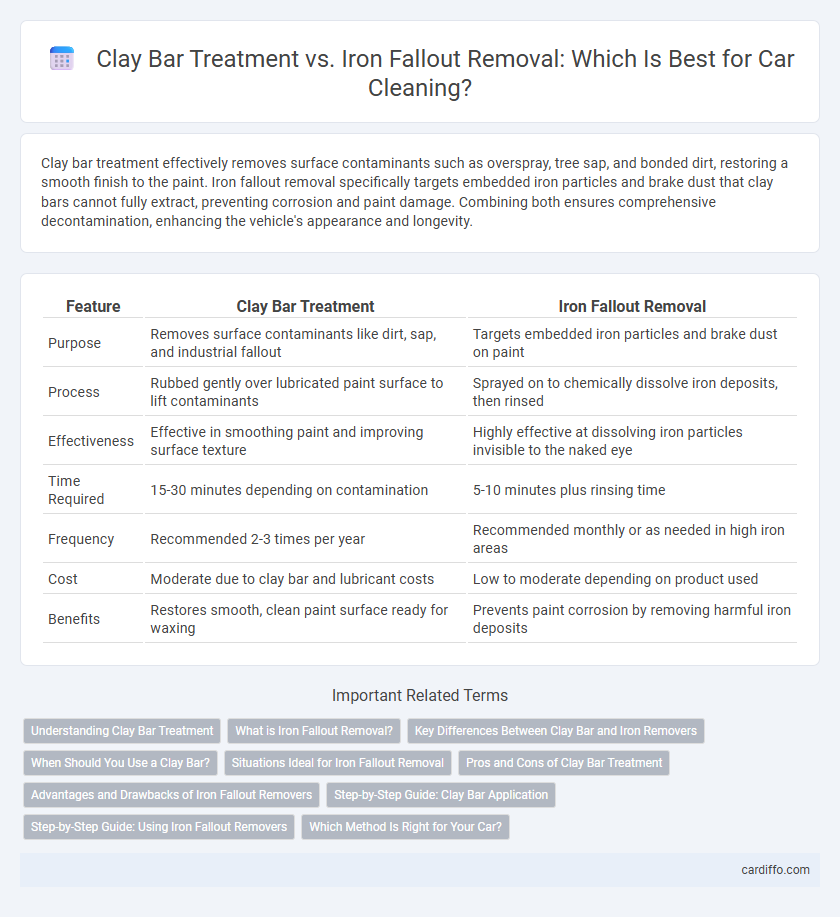Clay bar treatment effectively removes surface contaminants such as overspray, tree sap, and bonded dirt, restoring a smooth finish to the paint. Iron fallout removal specifically targets embedded iron particles and brake dust that clay bars cannot fully extract, preventing corrosion and paint damage. Combining both ensures comprehensive decontamination, enhancing the vehicle's appearance and longevity.
Table of Comparison
| Feature | Clay Bar Treatment | Iron Fallout Removal |
|---|---|---|
| Purpose | Removes surface contaminants like dirt, sap, and industrial fallout | Targets embedded iron particles and brake dust on paint |
| Process | Rubbed gently over lubricated paint surface to lift contaminants | Sprayed on to chemically dissolve iron deposits, then rinsed |
| Effectiveness | Effective in smoothing paint and improving surface texture | Highly effective at dissolving iron particles invisible to the naked eye |
| Time Required | 15-30 minutes depending on contamination | 5-10 minutes plus rinsing time |
| Frequency | Recommended 2-3 times per year | Recommended monthly or as needed in high iron areas |
| Cost | Moderate due to clay bar and lubricant costs | Low to moderate depending on product used |
| Benefits | Restores smooth, clean paint surface ready for waxing | Prevents paint corrosion by removing harmful iron deposits |
Understanding Clay Bar Treatment
Clay bar treatment effectively removes bonded surface contaminants such as dirt, industrial fallout, and overspray that regular washing cannot eliminate. Unlike iron fallout removal that targets ferrous particles embedded in the paint, clay bar treatment uses a lubricated bar to gently lift and trap these impurities without damaging the clear coat. This process restores smoothness, enhances paint clarity, and prepares the surface for polishing or sealing.
What is Iron Fallout Removal?
Iron fallout removal targets microscopic iron particles embedded in automotive paint, often from brake dust or industrial fallout, which can cause rust and paint damage over time. This process typically involves specialized chemical cleaners or iron removers that safely dissolve and lift iron contaminants without harming the clear coat. Compared to clay bar treatment, which removes surface contaminants like tar and overspray, iron fallout removal specifically addresses iron deposits that clay bars cannot effectively eliminate.
Key Differences Between Clay Bar and Iron Removers
Clay bar treatment physically removes bonded surface contaminants like overspray, road tar, and industrial fallout by gently abrading the clear coat, restoring smoothness to the paint. Iron fallout removers chemically dissolve embedded iron particles from brake dust and rail dust without abrasion, preventing rust stains and corrosion. While clay bars require manual rubbing and rinsing, iron removers often work with minimal agitation, targeting microscopic metallic contaminants invisible to the naked eye.
When Should You Use a Clay Bar?
Use a clay bar treatment when the vehicle's surface feels rough or has bonded contaminants like industrial fallout, tree sap, or overspray that ordinary washing cannot remove. This method restores smoothness and prepares the paint for polishing or waxing by removing embedded particles without damaging the clear coat. Employ clay bar treatment regularly during routine maintenance to maintain a clean and glossy finish before applying protective layers.
Situations Ideal for Iron Fallout Removal
Iron fallout removal is ideal for vehicles exposed to industrial pollution, brake dust accumulation, or frequent highway driving where metal particles embed in the paint. This specialized treatment targets iron contaminants that a clay bar cannot fully eliminate, preventing rust formation and paint damage. Regular iron fallout removal preserves the vehicle's finish and enhances the effectiveness of subsequent detailing steps.
Pros and Cons of Clay Bar Treatment
Clay bar treatment effectively removes surface contaminants like overspray, tree sap, and industrial fallout, restoring smoothness and enhancing paint clarity without abrasive damage. However, it requires proper lubrication and technique to avoid paint marring, and cannot fully eliminate embedded iron particles, which may need specialized iron fallout removers for thorough decontamination. Frequent use of clay bar treatment risks minor surface wear, making it ideal as part of a balanced detailing routine rather than a standalone solution.
Advantages and Drawbacks of Iron Fallout Removers
Iron fallout removers effectively dissolve embedded iron particles that traditional clay bars may fail to extract, enhancing paint surface cleanliness and preventing corrosion. These removers offer precise chemical action without excessive abrasion, minimizing the risk of surface scratches common with clay bar treatments. However, overuse or improper application of iron fallout removers can damage clear coats and paint finishes, necessitating careful adherence to product instructions and post-treatment protection.
Step-by-Step Guide: Clay Bar Application
Clay bar application begins by thoroughly washing and drying the vehicle to remove surface dirt and contaminants. Using a clay lubricant, glide the clay bar over small sections of the paintwork with gentle, back-and-forth motions to lift embedded particles. After treating each area, wipe the surface with a microfiber towel to ensure smoothness before moving on to the next section.
Step-by-Step Guide: Using Iron Fallout Removers
Begin iron fallout removal by thoroughly washing the vehicle to eliminate surface dirt and grime. Apply an iron fallout remover evenly across affected areas, allowing it to react with embedded iron particles until visible color change occurs, indicating contamination breakdown. Rinse off residue completely with water and follow up with a clay bar treatment to smooth the paint surface and remove any remaining contaminants.
Which Method Is Right for Your Car?
Clay bar treatment effectively removes surface contaminants like tar, tree sap, and overspray, restoring smoothness and enhancing paint clarity. Iron fallout removal targets embedded iron particles and brake dust that cannot be eliminated by a clay bar alone, preventing rust and paint damage. Choosing the right method depends on your car's condition--use clay bars for general surface cleansing and iron fallout removers when dealing with corrosion-prone iron deposits.
Clay bar treatment vs Iron fallout removal Infographic

 cardiffo.com
cardiffo.com